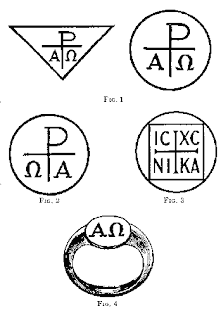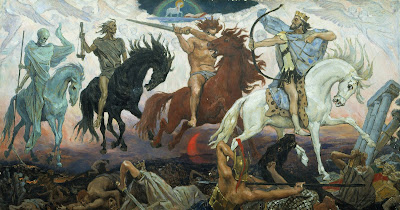 |
| "John of Patmos" by George Richmond |
Ch. 1 text and commentary (esv)
1 The revelation of Jesus Christ, which God gave him to show to his servants the things that must soon take place. He made it known by sending his angel to his servant John, 2 who bore witness to the word of God and to the testimony of Jesus Christ, even to all that he saw.3 Blessed is the one who reads aloud the words of this prophecy, and blessed are those who hear, and who keep what is written in it, for the time is near.
The book begins by calling itself the "revelation of Jesus Christ." The word "revelation" here means "unveiling, disclosure." As previous posts note, this word in Greek (apocalypsis) is loaded with meaning. An unveiling of Christ should bring to mind the moments in the Gospels that Christ's nature, power and divinity are unveiled, often with shocking results. Think of the Transfiguration (Mark 9) or the calming of the storm (Mark 4). This unveiling of Christ in this book was given in order that the servants (lit. "slaves") of Christ will see what must "soon" happen. There is always this urgency in apocalyptic and end-time teachings; the emphasis is on the here and now, the present, because now is the time to proclaim the victory of Jesus, before it's too late. John concludes this opening by saying the "time is near," thus emphasizing once again the urgency of reading, hearing, and keeping this prophecy.
4 John to the seven churches that are in Asia:
Grace to you and peace from him who is and who was and who is to come, and from the seven spirits who are before his throne, 5 and from Jesus Christ the faithful witness, the firstborn of the dead, and the ruler of kings on earth.
To him who loves us and has freed us from our sins by his blood 6 and made us a kingdom, priests to his God and Father, to him be glory and dominion forever and ever. Amen. 7 Behold, he is coming with the clouds, and every eye will see him, even those who pierced him, and all tribes of the earth will wail on account of him. Even so. Amen.
8 “I am the Alpha and the Omega,” says the Lord God, “who is and who was and who is to come, the Almighty.”
The "Apocalypse" of Jesus Christ, given to John by an angel ("messenger"), which is, indeed, a prophecy (vs. 3), is also a letter "to the seven churches that are in Asia." Asia during John's time was the Roman province of Asia:
Now the question arises: "Why seven churches?" Ancient writers surmised that "seven" is the perfect number because it combines three with four; three is the Tri-unity of the Godhead and four is the number of the corners of the world and also the Gospels. There are also seven days of creation. So, the seven churches signify and summarize the universal Church.
Then what does the "seven spirits before his throne?" The "seven spirits" have been interpreted in numerous ways. They act in Revelation like God's eyes, looking around the earth like a reconnaissance team (Koester, 227). They hearken back to the "seven lamps" and the "seven eyes"
There is also Zechariah 3:8, 9 to consider, where the angel of God is speaking to Joshua the high priest while Satan is nearby. "'Listen, High Priest Joshua, you and your associates seated before you, who are men symbolic of things to come: I am going to bring my servant, the Branch. See, the stone I have set in front of Joshua! There are seven eyes on that one stone, and I will engrave an inscription on it,’ says the Lord Almighty, ‘and I will remove the sin of this land in a single day.'"
This seven-eyed stone, linked as it is to the "Branch" (Messiah), is also connected to the removal of sin in a single day (the crucifixion). Elsewhere in the New Testament, Christ is called the "stone" (1 Cor. 10:4; Matt. 21:42), and is shown to be both the stone that gave Israel water in the wilderness and the stone of Psalm 118 which is a stumbling block and an offence which, nevertheless, becomes the corner stone.
Notice here the seven-fold presence of the Spirit: He is of the Lord, of wisdom, of understanding, of counsel, of might, of knowledge, of fear. This is another OT text that lies behind Revelation and the importance of the number "7" in relation to God and the Church. One scholar says, "Throughout Revelation the number seven represents God's presence by his Spirit" (Brighton, 42).
9 I, John, your brother and partner in the tribulation and the kingdom and the patient endurance that are in Jesus, was on the island called Patmos on account of the word of God and the testimony of Jesus. 10 I was in the Spirit on the Lord's day, and I heard behind me a loud voice like a trumpet 11 saying, “Write what you see in a book and send it to the seven churches, to Ephesus and to Smyrna and to Pergamum and to Thyatira and to Sardis and to Philadelphia and to Laodicea.”
12 Then I turned to see the voice that was speaking to me, and on turning I saw seven golden lampstands, 13 and in the midst of the lampstands one like a son of man, clothed with a long robe and with a golden sash around his chest. 14 The hairs of his head were white, like white wool, like snow. His eyes were like a flame of fire, 15 his feet were like burnished bronze, refined in a furnace, and his voice was like the roar of many waters. 16 In his right hand he held seven stars, from his mouth came a sharp two-edged sword, and his face was like the sun shining in full strength.
17 When I saw him, I fell at his feet as though dead. But he laid his right hand on me, saying, “Fear not, I am the first and the last, 18 and the living one. I died, and behold I am alive forevermore, and I have the keys of Death and Hades. 19 Write therefore the things that you have seen, those that are and those that are to take place after this. 20 As for the mystery of the seven stars that you saw in my right hand, and the seven golden lampstands, the seven stars are the angels of the seven churches, and the seven lampstands are the seven churches.
 |
| An ancient manuscript of the New Testament. Virtually all of the oldest copies of NT books are found on decaying papyrus like this. |
 |
| Map of Eastern Mediterranean (notice Patmos) |
John was "in the Spirit" on the "Lord's Day," meaning he received the revelation of Jesus on Sunday, presumably when he had been worshiping his Lord and partaking of the body and blood of Jesus in the Eucharist. Then he hears a loud voice like a trumpet.
Christians have generally accepted that the seven churches sum up all of the Christian congregations. Again, seven is the number of completeness (3 + 4) and is also the number of God's design for the world (7 days of creation). These seven churches are all located in what is today Western Turkey.
The "one like a son of man" should make us recall Daniel's vision of the son of man (recorded in Daniel 7), and Jesus's self-identifying as the son of man throughout the Gospels. The son of man is the apocalyptic figure of God's authority and judgment. Daniel 7:13, 14 reads, "“In my vision at night I looked, and there before me was one like a son of man, coming with the clouds of heaven. He approached the Ancient of Days and was led into his presence. He was given authority,glory and sovereign power; all nations and peoples of every language worshiped him. His dominion is an everlasting dominion that will not pass away, and his kingdom is one that will never be destroyed."
Since Jesus identifies as this son of man (e.g. Matt. 20:28 and elsewhere), we can confidently say that the son of man in this vision is Jesus. Yet, this is Jesus in His glory and power. The fierce description is like God has lifted the veil over John's eyes and showed him the Son's radiant being. This one, who is both Lord and God, has defeated death and risen from the grave. He is exalted, and approaches John. We can only imagine how frightening, shocking, and powerful this vision was!
The seven lampstands hearken back to the menorah of Moses, a seven-fold lampstand (Exodus 25), and represent the seven churches. The seven stars are the seven angels of the churches





